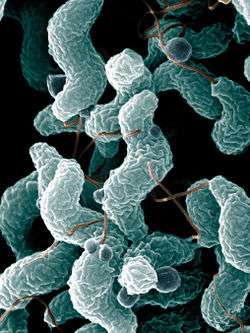Campylobacter coli
| Campylobacter coli | |
|---|---|
 | |
| Scientific classification | |
| Kingdom: | Bacteria |
| Phylum: | Proteobacteria |
| Class: | Epsilonproteobacteria |
| Order: | Campylobacterales |
| Family: | Campylobacteraceae |
| Genus: | Campylobacter |
| Species: | C. coli |
| Binomial name | |
| Campylobacter coli (Doyle, 1948) Véron and Chatelain, 1973 | |
Campylobacter coli is a Gram-negative, microaerophilic, nonendospore-forming, S-shaped bacterial species within genus Campylobacter.[1]
Human infection
At least a dozen species of Campylobacter have been implicated in human disease (campylobacteriosis), with C. jejuni and C. coli the most common. In humans, 85% to 95% of infections by the Campylobacter species involve C. jejuni, while C. coli is involved in a majority of the other cases.[1] The bacterium is also found in cattle, swine, and birds. Similar to the C. jejuni, C. coli has the ability to cause enteritis with symptoms such as abdominal pain, diarrhea, bloody stool, and fever. These symptoms are caused, in part, by a secreted cytolethal distending toxin.[2]
See also
References
External links
This article is issued from Wikipedia - version of the 6/7/2016. The text is available under the Creative Commons Attribution/Share Alike but additional terms may apply for the media files.